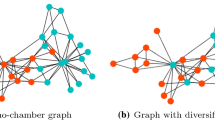Abstract
The fast development of multimedia technology and increasing availability of network bandwidth has given rise to an abundance of network data as a result of all the ever-booming social media and social websites in recent years, e.g., Flickr, Youtube, MySpace, Facebook, etc. Social network analysis has therefore become a critical problem attracting enthusiasm from both academia and industry. However, an important measure that captures a participant’s diversity in the network has been largely neglected in previous studies. Namely, diversity characterizes how diverse a given node connects with its peers. In this paper, we give a comprehensive study of this concept. We first lay out two criteria that capture the semantic meaning of diversity, and then propose a compliant definition which is simple enough to embed the idea. Based on the approach, we can measure not only a user’s sociality and interest diversity but also a social media’s user diversity. An efficient top-k diversity ranking algorithm is developed for computation on dynamic networks. Experiments on both synthetic and real social media datasets give interesting results, where individual nodes identified with high diversities are intuitive.









Similar content being viewed by others
Notes
DC and BC denote degree and betweenness centrality for short respectively in this paper.
SN denotes synthetic network for short.
FN denotes the social network of American football games for short.
References
Barabasi AL, Oltvai ZN (2004) Network biology: understanding the cell’s functional organization. Nat Rev Genet 5(2):101–113
Blei D, Ng A, Jordan M (2003) Latent dirichlet allocation. J Mach Learn Res 3:993–1022
Brandes U (2001) A faster algorithm for betweenness centrality. J Math Sociol 25:163–177
Cover TM, Thomas JA (2006) Elements of information theory. Wiley
Faloutsos M, Faloutsos P, Faloutsos C (1999) On power-law relationships of the internet topology. In: SIGCOMM, pp 251–262
Gibson D, Kumar R, Tomkins A (2005) Discovering large dense subgraphs in massive graphs. In: VLDB, pp 721–732
Girvan M, Newman MEJ (2002) Community structure in social and biological networks. Proc Natl Acad Sci 99(12):7821–7826
Hwang W, Kim T, Ramanathan M, Zhang A (2008) Bridging centrality: graph mining from element level to group level. In: KDD, pp 336–344
Jeh G, Widom J (2002) Simrank: a measure of structural-context similarity. In: KDD, pp 538–543
Kempe D, Kleinberg J, Tardos E (2003) Maximizing the spread of influence through a social network. In: KDD, pp 137–146
Kossinets G, Kleinberg JM, Watts DJ (2008) The structure of information pathways in a social communication network. In: KDD, pp 435–443
Kuramochi M, Karypis G (2001) Frequent subgraph discovery. In: ICDM, pp 313–320
Lawrence P, Sergey B, Motwani R, Winograd T (1998) The pagerank citation ranking: bringing order to the web. Technical report, Stanford University
Leskovec J, Kleinberg JM, Faloutsos C (2005) Graphs over time: densification laws, shrinking diameters and possible explanations. In: KDD, pp 177–187
Ng AY, Jordan MI, Weiss Y (2001) On spectral clustering: analysis and an algorithm. In: NIPS, pp 849–856
Pei J, Jiang D, Zhang A (2005) On mining cross-graph quasi-cliques. In: KDD, pp 228–238
Putnam RD (1995) Bowling alone: America’s declining social capital. J Democr 6(1):65–78
Spirin V, Mirny LA (2003) Protein complexes and functional modules in molecular networks. Proc Natl Acad Sci USA 100(21):12123–12128
Stephenson K, Zelen M (1989) Rethinking centrality: methods and examples. Soc Netw 11(1):1–37
Sun Y, Han J, Zhao P, Yin Z, Cheng H, Wu T (2009) Rankclus: integrating clustering with ranking for heterogeneous information network analysis. In: EDBT, pp 565–576
Wasserman S, Faust K (1994) Social network analysis, methods and applications. Cambridge University Press
Watts DJ, Strogatz SH (1998) Collective dynamics of ‘small-world’ networks. Nature 393(6684):440–442
Yan X, Han J (2002) gSpan: graph-based substructure pattern mining. In: ICDM, pp 721–724
Zvi MR, Griffiths T, Steyvers M, Smyth P (2004) The author-topic model for authors and documents. In: UAI, pp 487–494
Acknowledgements
The work was supported in part by the U.S. National Science Foundation grants IIS-08-42769 and IIS-09-05215, and the NASA grant NNX08AC35A, and 973 Program of China grant 2006CB303103, and the State Key Program of National Natural Science of China grant 60933013. Any opinions, findings, and conclusions expressed here are those of the authors and do not necessarily reflect the views of the funding agencies.
Author information
Authors and Affiliations
Corresponding author
Rights and permissions
About this article
Cite this article
Liu, L., Zhu, F., Jiang, M. et al. Mining diversity on social media networks. Multimed Tools Appl 56, 179–205 (2012). https://doi.org/10.1007/s11042-010-0568-1
Published:
Issue Date:
DOI: https://doi.org/10.1007/s11042-010-0568-1




